Korean radishes, known as mu, are a staple in Korean cuisine, recognized for their firm, juicy texture and slightly sweet, crunchy taste. These vegetables are generally short and stout, with a pale green shade halfway down from the top, making them easy to spot in the market.
Korean radishes are versatile ingredients found in many dishes, from pickled sides to spicy salads, and are often used to make musaengchae, a spicy radish salad that serves as a great substitute for kimchi and adds a refreshing crunch to bibimbap. Good Korean radishes are firm, dense, and have shiny skin, which is crucial for their flavor and texture in recipes.
For those interested in trying their hand at Korean cooking, knowing how to choose and use mu can elevate their culinary skills. Whether adding them to a stew or enjoying them pickled, Korean radishes offer a unique, delicious, and nutritious taste.
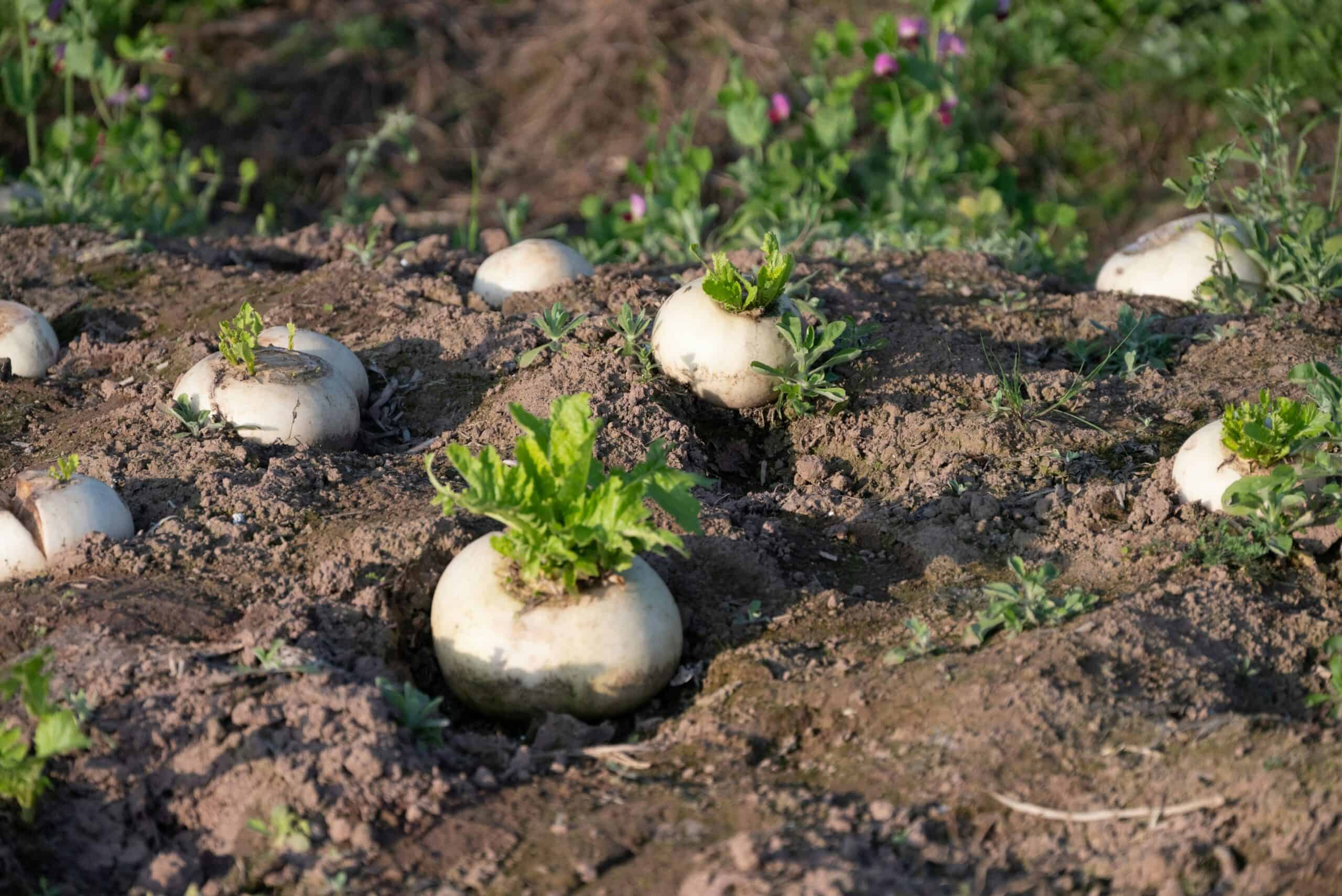
Jump to:
🌱 Understanding Korean Radishes
Botanical Profile
Korean radishes are stout, cylindrical root vegetables that typically weigh around 800 grams (28 oz) and measure about 20 centimeters (7.9 in) in length.
They feature a pale green top that transitions to white as you move down the root. The flesh is crisp, juicy, and slightly peppery when harvested at the right time, while their skin is firm and smooth, offering a sweet and mild flavor.
Key Characteristics:
- Weight: ~800 grams (28 oz)
- Length: ~20 centimeters (7.9 in)
- Top Color: Pale green
- Flavor: Sweet, crisp, and slightly peppery
Comparing Mu and Daikon
While both mu and daikon radishes belong to the same family, they differ in several ways. Mu is shorter and stouter with sweet, firm flesh, while daikon is usually longer, more cylindrical, and can taste milder and less sweet. Additionally, the skin of mu tends to be smoother and thicker compared to daikon's thinner skin.
Comparison Table:
| Feature | Mu | Daikon |
|---|---|---|
| Length | ~20 cm (7.9 in) | Longer, up to 60 cm |
| Shape | Stout and cylindrical | Long and cylindrical |
| Flavor | Sweet and firm | Milder and less sweet |
| Skin | Thick and smooth | Thin and smooth |
Seasonality and Cultivation
Korean radishes are typically planted in late fall and thrive in cool weather, growing best in fertile, well-drained soil rich in organic matter. Optimal temperatures for growing mu are between 50-68°F (10-20°C). The radishes are harvested when they reach about 800 grams, ensuring the flesh is firm and juicy.
Farmers use specific techniques to ensure that radishes develop the right texture and flavor. Proper irrigation is crucial for maintaining moisture in the soil, which helps the roots stay juicy and crisp. Additionally, rotating crops prevents soil depletion and helps control pests and diseases.
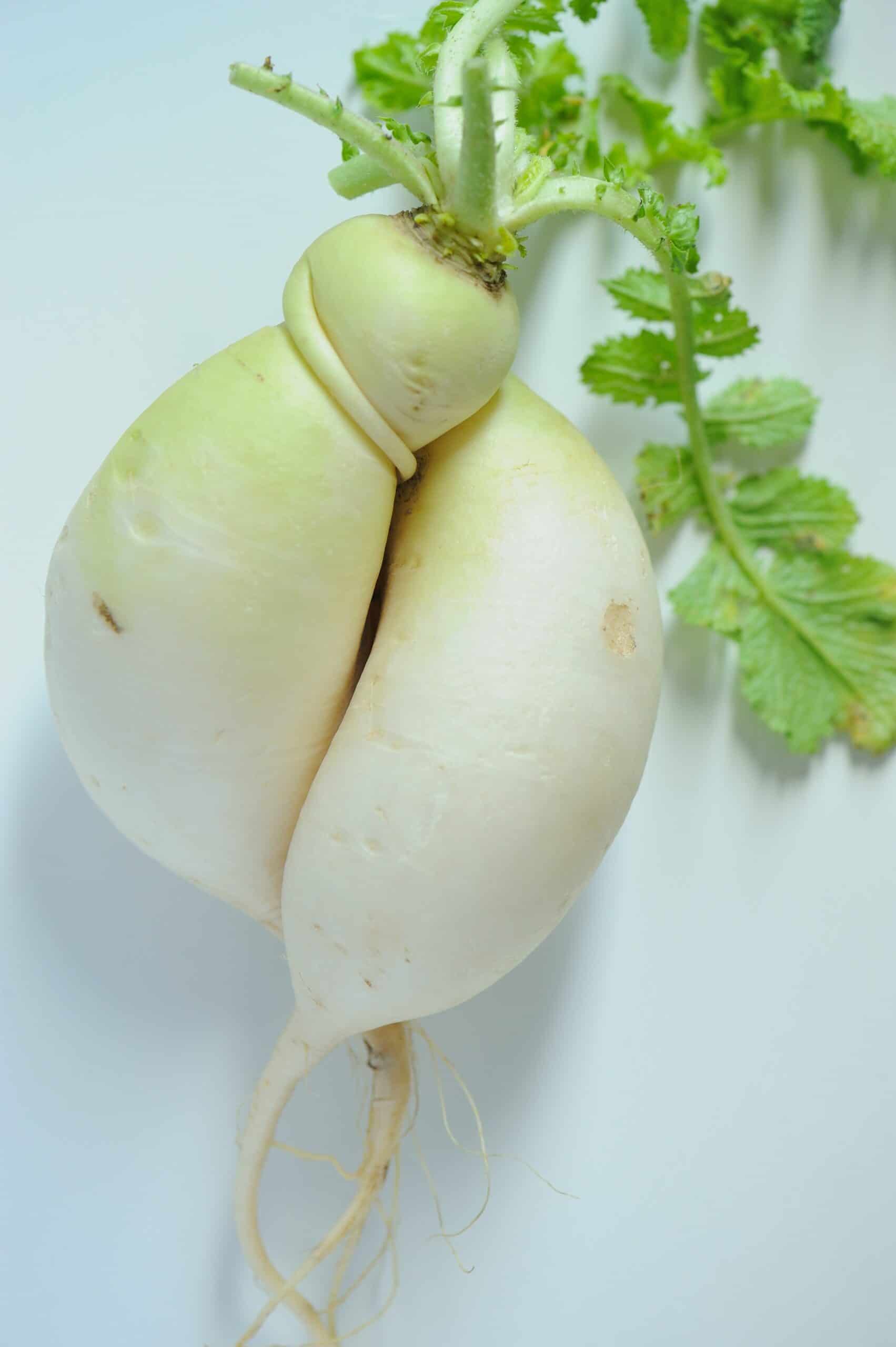
🔪 Preparing and Storing Mu
Washing and Peeling
It's important to wash mu thoroughly under cold running water to remove dirt and pesticides, using a vegetable brush if needed. After washing, peel the radish with a vegetable peeler.
Once peeled, remove the skin to ensure it's clean and ready for cooking or pickling. Then, pat the radish dry with a paper towel to remove excess moisture, which is crucial for maintaining its crunchy texture.
Cutting Techniques
Mu can be cut in several ways, depending on the dish. For kimchi, it's often sliced into thin matchsticks, which helps the radish absorb flavors quickly.
If you’re preparing side dishes like pickled radishes, cutting them into even cubes works well, as cubes ensure a uniform texture and taste. Experiment with different shapes, like thin rounds or small chunks, to see what works best in your recipes.
Storage Tips
To store mu, keep it in the refrigerator wrapped in a paper towel to absorb moisture and place it in a plastic bag. This prevents the radish from becoming spongy.
For optimal freshness, it's best to store this bag of radishes in the crisper drawer, checking regularly for any signs of spoilage. When stored properly, they can last for several weeks while retaining their crunchy texture.
😋 Flavors and Textures
Taste Profile
Korean radishes are notably sweet with a gentle hint of spiciness, and this sweetness is more pronounced when the radish is fresh. Unlike other radishes that can be quite pungent, mu offers a mild and pleasant flavor.
You might also notice a slight sour undertone in some dishes, especially in pickled forms, making Korean radishes versatile for both raw and cooked dishes due to their combination of sweet and sour flavors.
When pickled, Korean radishes can take on a bit of a salty taste, adding another layer of flavor complexity. This balance of sweet, sour, and salty flavors makes them a unique ingredient.
Texture Characteristics
The texture of Korean radishes is firm and crunchy, providing a satisfying crispness when you bite into a fresh mu. This crunch remains even after the radish is cooked or pickled.
Unlike radishes that can get mushy when cooked, mu maintains its firm texture, making it ideal for soups and stews. Even when pickled, the radish still retains a good amount of its original crunch, adding a pleasing texture contrast to dishes.
The outer skin of the Korean radish is thin, and its flesh is dense without being hard, giving it a tender yet crisp texture that stands out in various culinary applications.
Often diced or sliced thin to best showcase their texture, Korean radishes provide an enjoyable eating experience, whether served as a side dish or as a main course.
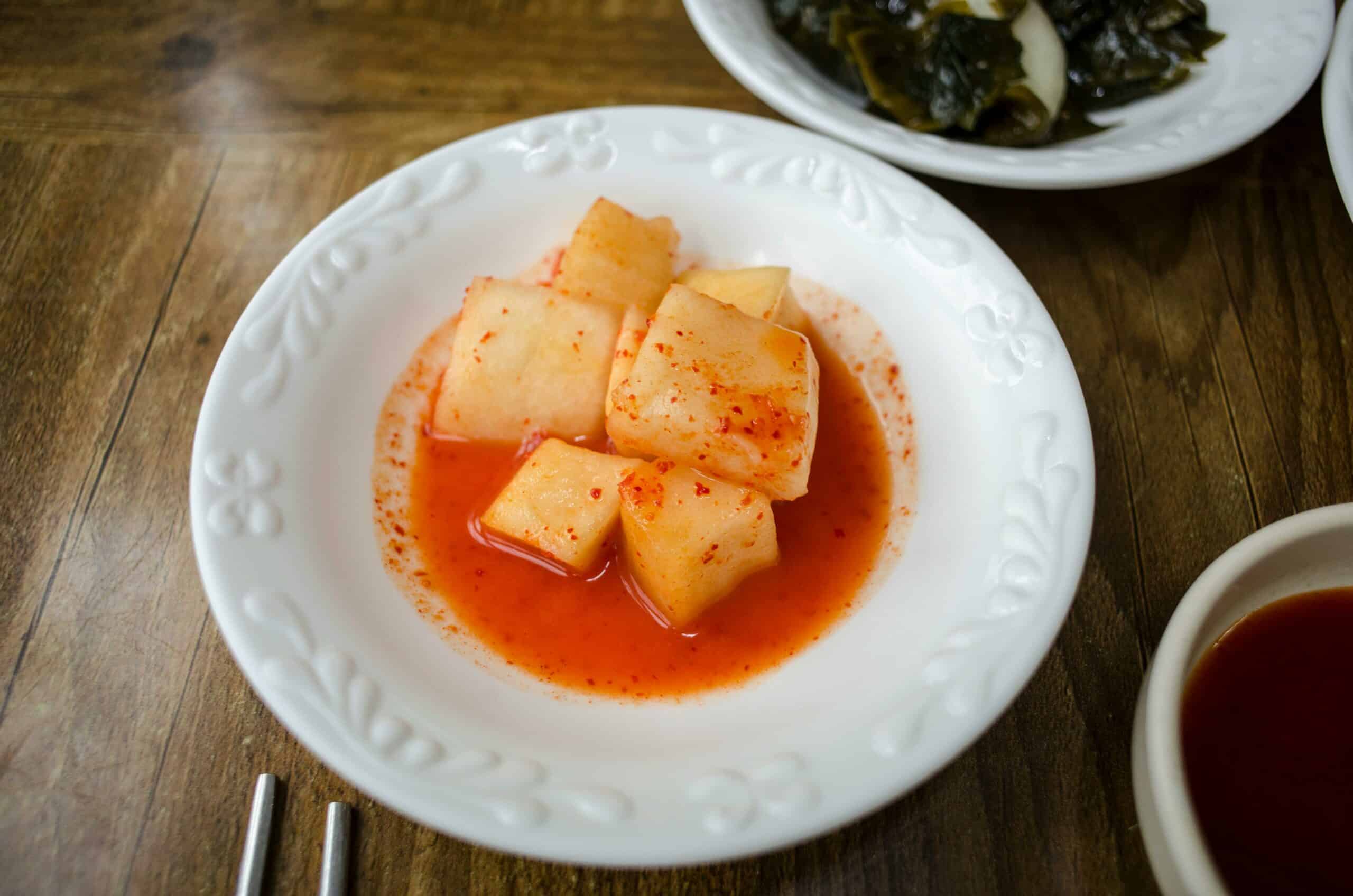
👨🍳 Culinary Uses
Traditional Korean Dishes
Korean radishes are key ingredients in classic dishes such as kimchi, where they add a crunchy texture and absorb spices well, and in muck, a comforting beef and radish soup that's easy to make.
Another popular dish is musaengchae, a spicy shredded radish salad that's slightly sweet and tangy. This dish highlights the radish's ability to complement bold flavors while providing refreshing bites.
Modern Kitchen Applications
In modern kitchens, Korean radishes are used in diverse ways, often pickled and found in sandwiches, tacos, or as a side dish. Pickled radish, such as ssam-mu, adds a zesty crunch to wraps and barbecues.
Thinly sliced mu makes an excellent addition to salads, giving them a crisp texture, and can also be roasted or stir-fried with garlic and soy sauce for a simple yet flavorful side.
These methods showcase the radish’s adaptability to various cooking styles outside its traditional roots, making it a handy ingredient in any kitchen.
🥣 Korean Radish's Role in Banchan
Kimchi Variations
Korean radish is a star in many kimchi varieties, such as kkakdugi, where radish cubes are fermented with chili powder, garlic, and ginger to create a crisp and spicy dish that provides a refreshing contrast to heavier main courses.
Dongchimi, another beloved radish kimchi, contrasts with kkakdugi by being a non-spicy, watery kimchi made with radish, water, garlic, and ginger, serving as a light and refreshing accompaniment to meals.
These radish-based kimchis, staples in Korean households, provide essential nutrients and flavor, while dishes like these are indispensable for balancing traditional Korean meals with their added texture and taste.
Pickled Delights
The Korean radish, often served with fried chicken, takes center stage in various pickled dishes, providing a sweet, tangy, and crunchy experience. It's made by soaking radish cubes in a mixture of vinegar, sugar, and salt.
Musaengchae, a spicy radish salad, is another simple yet tasty option made by mixing radish matchsticks with gochugaru (Korean red chili flakes), garlic, and a little sugar. This side dish is quick to prepare and packs a flavorful punch.
Korean radish's versatility and distinct flavor make it a standout in Korean cuisine, complementing main dishes and acting as a palate cleanser. These pickled delights are essential in any set of banchan.
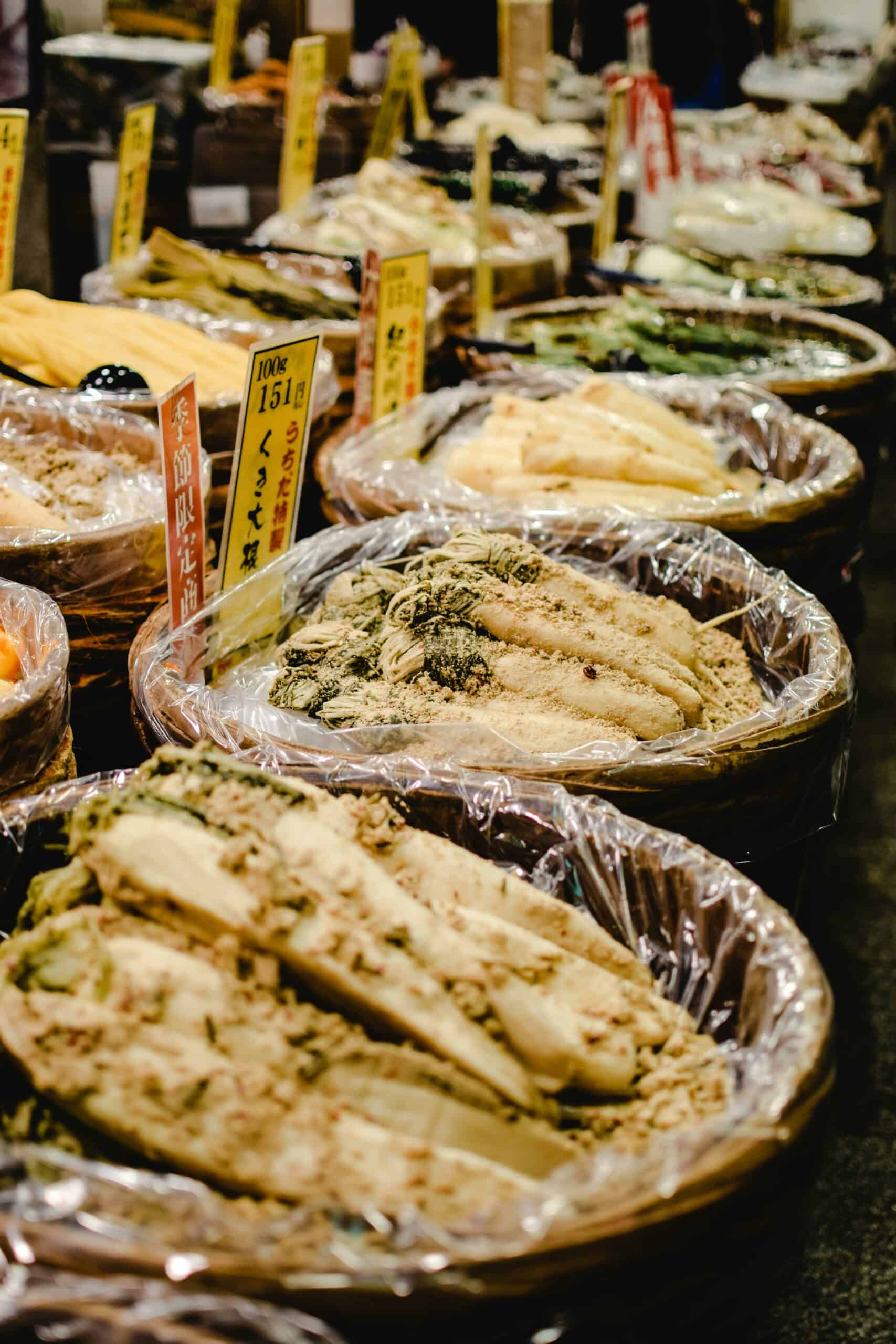
🩺 Health Benefits and Nutrition
Nutritional Value
Korean radishes are low in calories, making them a great addition to any diet. Here’s a basic breakdown of their nutritional content per 100 grams:
| Nutrient | Amount |
|---|---|
| Calories | 16 |
| Carbohydrates | 3.4 grams |
| Dietary Fiber | 1.6 grams |
| Vitamin C | 14 milligrams |
| Calcium | 27 milligrams |
| Potassium | 230 milligrams |
Health Benefits
Boosts Immune System: Rich in vitamin C, radishes help strengthen the immune system, keeping colds and infections at bay.
Aids Digestion: They contain dietary fiber, which promotes healthy digestion and prevents constipation. Adding mu to meals can keep your digestive system running smoothly.
Weight Loss: Low in calories and high in water content, these radishes can help with weight management. Eating low-calorie foods like Korean radishes can help you feel full without consuming too many calories.
Heart Health: Radishes are thought to lower the risk of heart disease by managing blood pressure and cholesterol levels.
Detoxification: The natural compounds in Korean radishes can support liver function and help detoxify the body. This is particularly useful in purging toxins and keeping the body clean.
😉 Special Tips and Tricks
Achieving the Best Crunch
To achieve the perfect crunch, start with good-quality radishes that are heavy, smooth, and firm, featuring a pale green top transitioning to white, and avoid those with too much green near the head, as they may be overexposed to the sun.
Salting the radish is crucial for maintaining a crunchy texture; coarse salt is ideal for drawing out excess moisture. Sprinkle it over the radish sticks and let them sit for about 30 minutes.
Using an airtight container is also important; after salting, store the radishes in an airtight container to prevent them from becoming too soft or losing their crunch.
Flavor Enhancing Techniques
Flavor enhancement begins with a brine; combine water, rice vinegar, and sugar in the correct proportions and stir until the sugar dissolves completely, forming a sweet and tangy base that complements the radish's natural flavor.
Consider adding extra ingredients like garlic or red chili flakes to the brine for more depth, as these additions can make the flavor profile more interesting.
Finally, give the radishes enough time to absorb the flavors. The pickling process should ideally last from a few hours to overnight in the fridge, allowing the flavors to penetrate deeply into the radish and offering a delicious, well-balanced taste when ready to eat.
🔍 Sourcing and Quality Indicators
When looking for high-quality Korean radishes, focus on their appearance and weight. Good radishes should have shiny, smooth skin without scratches or blemishes, as these imperfections may indicate poor handling or lower quality.
Korean radishes are typically shorter and denser than other varieties, and they should feel heavier than they look, which signals dense flesh and high water content.
Quality Indicators:
| Indicator | Description |
|---|---|
| Shiny Skin | Bright and smooth surface |
| Heavier | Feels heavy for its size |
| Dense Flesh | Thick and firm when pressed lightly |
| Shorter | Compact and stout shape |
| No Scratches | Free from visible blemishes |
Shoppers should also inspect the radish greens, as fresh, crisp leaves indicate a healthy radish, while wilting leaves may suggest age or improper storage. In markets, it's best to buy Korean radishes from high-turnover stalls, where fresh produce is frequently restocked.
❓ Frequently Asked Questions
Korean radishes can be used in soups, stews, and braises. They're also perfect for pickling, adding to salads, and pairing with grilled meats. Their firm texture and mild flavor make them a favorite in Korean cuisine.
To make pickled Korean radish, slice the radishes thinly. Mix water, rice vinegar, and sugar until the sugar dissolves. Pour this brine over the radish slices and let them sit for several hours or overnight.
Daikon and Korean radishes are similar but have distinct differences. Daikon is more elongated and mild-flavored, whereas Korean radish is shorter, stubbier, and slightly sweeter. Both can be used interchangeably in many recipes but bring unique tastes and textures.
Korean radishes are low in calories and rich in vitamins. They provide vitamin C, fiber, and antioxidants. These nutrients help with digestion and can boost the immune system. Including them in your diet supports overall health.
For a tasty Korean radish kimchi, chop the radishes into small cubes. Mix them with gochugaru (Korean chili powder), garlic, ginger, and fish sauce. Let the mixture ferment for a few days. This dish is spicy, tangy, and a great side for Korean meals.

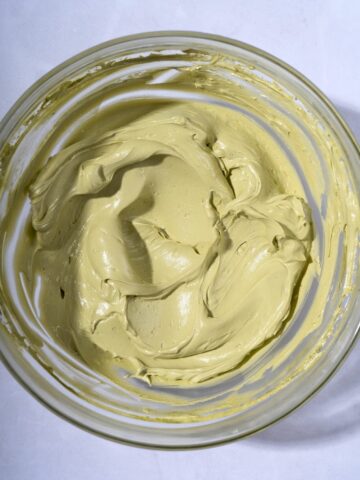
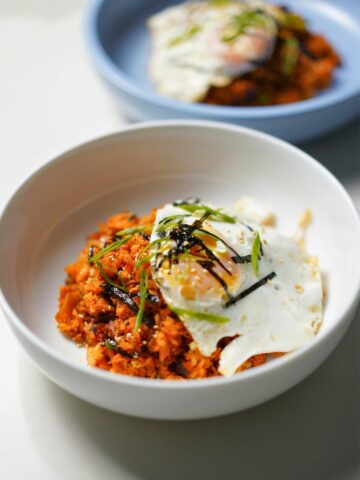
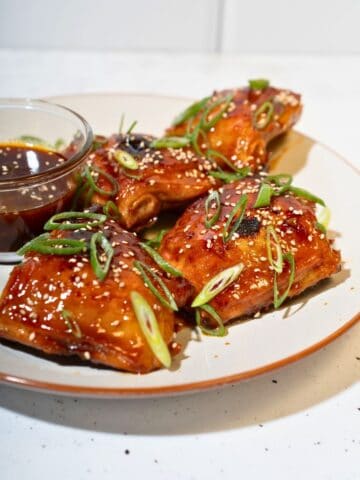
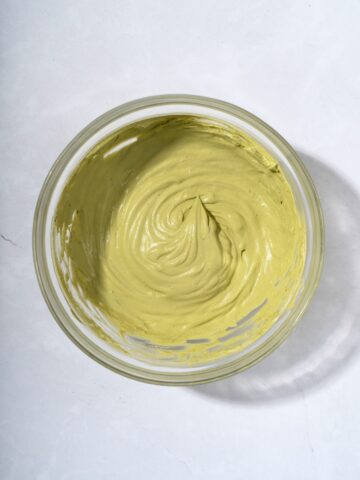
Comments
No Comments